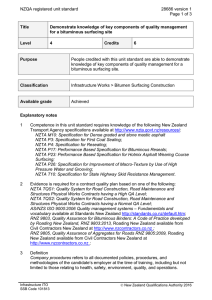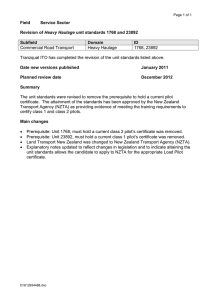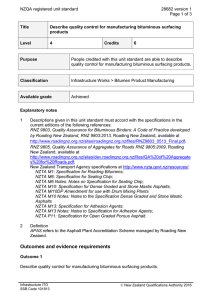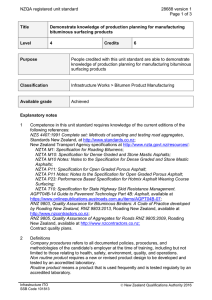NZQA registered unit standard 21664 version 2 Page 1 of 6
advertisement
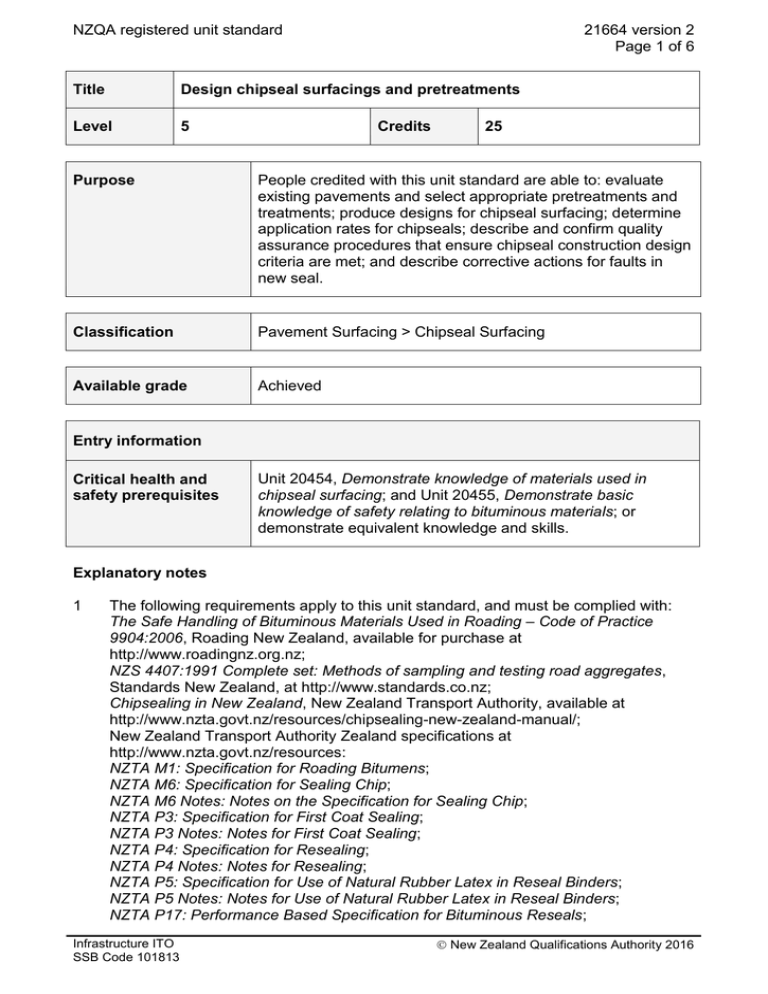
NZQA registered unit standard 21664 version 2 Page 1 of 6 Title Design chipseal surfacings and pretreatments Level 5 Credits 25 Purpose People credited with this unit standard are able to: evaluate existing pavements and select appropriate pretreatments and treatments; produce designs for chipseal surfacing; determine application rates for chipseals; describe and confirm quality assurance procedures that ensure chipseal construction design criteria are met; and describe corrective actions for faults in new seal. Classification Pavement Surfacing > Chipseal Surfacing Available grade Achieved Entry information Critical health and safety prerequisites Unit 20454, Demonstrate knowledge of materials used in chipseal surfacing; and Unit 20455, Demonstrate basic knowledge of safety relating to bituminous materials; or demonstrate equivalent knowledge and skills. Explanatory notes 1 The following requirements apply to this unit standard, and must be complied with: The Safe Handling of Bituminous Materials Used in Roading – Code of Practice 9904:2006, Roading New Zealand, available for purchase at http://www.roadingnz.org.nz; NZS 4407:1991 Complete set: Methods of sampling and testing road aggregates, Standards New Zealand, at http://www.standards.co.nz; Chipsealing in New Zealand, New Zealand Transport Authority, available at http://www.nzta.govt.nz/resources/chipsealing-new-zealand-manual/; New Zealand Transport Authority Zealand specifications at http://www.nzta.govt.nz/resources: NZTA M1: Specification for Roading Bitumens; NZTA M6: Specification for Sealing Chip; NZTA M6 Notes: Notes on the Specification for Sealing Chip; NZTA P3: Specification for First Coat Sealing; NZTA P3 Notes: Notes for First Coat Sealing; NZTA P4: Specification for Resealing; NZTA P4 Notes: Notes for Resealing; NZTA P5: Specification for Use of Natural Rubber Latex in Reseal Binders; NZTA P5 Notes: Notes for Use of Natural Rubber Latex in Reseal Binders; NZTA P17: Performance Based Specification for Bituminous Reseals; Infrastructure ITO SSB Code 101813 New Zealand Qualifications Authority 2016 NZQA registered unit standard 21664 version 2 Page 2 of 6 NZTA P17 Notes: Notes for the Specification for Bituminous Reseals; NZTA P26: Specification for Improvement of Pavement Macrotexture; NZTA P26 Notes: Notes to the Specification for Improvement of Pavement Macrotexture; NZTA Q1: Specification for Quality Assurance for Chipsealing; NZTA Q1 Notes & NZTA Q2 Notes: Notes to Specifications for Quality Assurance for Chipsealing and Hot Mix Asphalt; NZTA T10: Specification for State Highway Skid Resistance Management; NZTA T10 Notes: Notes to the Specification for State Highway Skid Resistance Management; Contract specifications. Any requirements superseding any of the above will apply, pending the review of this unit standard. 2 Assessment against this unit standard must be based on evidence from a workplace context. 3 For competence in this unit standard candidates are to produce designs for at least three of: first coat seal, single coat reseal on asphalt, single coat reseal on chipseal, two coat reseal, reseal using emulsified binder, reseal using modified binder. 4 Definitions Company procedures refers to all documented policies, procedures and methodologies of the candidate’s employer at the time of training including but not limited to those relating to health, safety, environment, quality, and operations. Maintenance period means the period of time from the removal of temporary speed restrictions until final acceptance by the engineer during which time the contractor may have corrective action obligations specified in the contract specifications. Protection period means the period of time from the completion of rolling until the removal of temporary speed restrictions during which time the contractor may have corrective action obligations specified in the contract specifications. PSV means polished stone value as defined in NZTA M6. RAMM means Transfund New Zealand’s roading asset management method. Outcomes and evidence requirements Outcome 1 Evaluate existing pavements and select appropriate pretreatments and treatments. Evidence requirements 1.1 Factors influencing treatment selection and choice of surfacing are described in accordance with Chipsealing in New Zealand. Range Infrastructure ITO SSB Code 101813 include but are not limited to – condition, texture, and variability of existing surface; geometry, number of lanes, gradients, and corners; approaches to intersections; traffic volumes and mix; climatic conditions and shading; management systems such as RAMM. New Zealand Qualifications Authority 2016 NZQA registered unit standard 1.2 21664 version 2 Page 3 of 6 Types of surface distress and presealing repairs are described in accordance with Chipsealing in New Zealand. Range distress types include but are not limited to – skid resistance, flushing, chip loss, cracking, ravelling, scabbing, rutting; repairs – drainage, shoulders, edge breaks, surface texture variation, pre-levelling. 1.3 Situations where chipsealing a surface would be inappropriate are identified in accordance with Chipsealing in New Zealand. 1.4 Existing surfaces are evaluated for treatment selection in accordance with Chipsealing in New Zealand. Range 1.5 existing surfaces may include but are not limited to – unbound basecourse, stabilised basecourse, chipseal, dense-graded asphalt, open-graded asphalt, slurry seal, cement concrete; treatment may include – irregular textured surface, cracked surfaces, deformed surfaces. Treatments are selected to meet client requirements in accordance with Chipsealing in New Zealand and taking account of existing surface and site conditions. Range treatments may include but are not limited to – single coat, multicoat; requirements may include but are not limited to – skid resistance, traffic stress, noise limitation, cost; conditions may include but are not limited to – cracking, flushing. Outcome 2 Produce designs for chipseal surfacing. Evidence requirements 2.1 Design parameters are described in accordance with Chipsealing in New Zealand. 2.2 Design processes are implemented in accordance with contract specifications, Chipsealing in New Zealand, and company procedures. 2.3 Designs are described in terms of compatibility with site constraints and available construction plant. Range 2.4 constraints include but are not limited to – shade, height, width, gradient, geometry. Designs are produced to meet safety and environmental requirements for minimising the use of hazardous substances such as fluxes, cutters, modifiers, and adhesion agents. Infrastructure ITO SSB Code 101813 New Zealand Qualifications Authority 2016 NZQA registered unit standard 2.5 Design reports are prepared in accordance with Chipsealing in New Zealand. Range 2.6 21664 version 2 Page 4 of 6 may include but are not limited to – texture; pretreatment(s); seal type, chip size and quantity; PSV; binder and chip application rates; areas to be sealed; additives. Chipseal designs are reported, audited, and confirmed in accordance with company procedures. Outcome 3 Determine application rates for chipseals. Evidence requirements 3.1 Binder application rate is determined in accordance with Chipsealing in New Zealand and the manufacturer’s recommendations. 3.2 Chip application rate is determined in accordance with Chipsealing in New Zealand. Outcome 4 Describe and confirm quality assurance procedures that ensure chipseal construction design criteria are met. Evidence requirements 4.1 Quality assurance procedures are described in terms of preseal repairs. Range 4.2 Field measurements and materials sampling and testing requirements are confirmed in accordance with contract specifications. Range 4.3 repairs include but are not limited to – flushing, bleeding, minor chip loss, major chip loss. measurements – area, sand circle, temperature, binder application rate, chip application rate; sampling and testing – binder, chip. Construction site requirements are confirmed in accordance with contract specifications and Chipsealing in New Zealand. Range Infrastructure ITO SSB Code 101813 preparation of surfaces, influence of weather, site conditions. New Zealand Qualifications Authority 2016 NZQA registered unit standard 21664 version 2 Page 5 of 6 Outcome 5 Describe corrective actions for faults in new seal. Range faults – minor and major chip loss, flushing, bleeding; chip loss resulting from – light binder application rate, frost, rain, traffic stress; unsuitable binder, binder absorption. Evidence requirements 5.1 Corrective actions are described in terms of seal repairs required during the protection period. 5.2 Corrective actions are described in terms of seal repairs required during the maintenance period. Replacement information This unit standard replaced unit standard 1499. Planned review date 31 December 2016 Status information and last date for assessment for superseded versions Process Version Date Last Date for Assessment Registration 1 27 October 2005 31 December 2013 Review 2 15 March 2012 N/A Consent and Moderation Requirements (CMR) reference 0101 This CMR can be accessed at http://www.nzqa.govt.nz/framework/search/index.do. Please note Providers must be granted consent to assess against standards (accredited) by NZQA, before they can report credits from assessment against unit standards or deliver courses of study leading to that assessment. Industry Training Organisations must be granted consent to assess against standards by NZQA before they can register credits from assessment against unit standards. Providers and Industry Training Organisations, which have been granted consent and which are assessing against unit standards must engage with the moderation system that applies to those standards. Requirements for consent to assess and an outline of the moderation system that applies to this standard are outlined in the Consent and Moderation Requirements (CMR). The CMR also includes useful information about special requirements for organisations wishing to develop education and training programmes, such as minimum qualifications for tutors and assessors, and special resource requirements. Infrastructure ITO SSB Code 101813 New Zealand Qualifications Authority 2016 NZQA registered unit standard 21664 version 2 Page 6 of 6 Comments on this unit standard Please contact Infrastructure ITO askus@infratrain.co.nz if you wish to suggest changes to the content of this unit standard. Infrastructure ITO SSB Code 101813 New Zealand Qualifications Authority 2016
